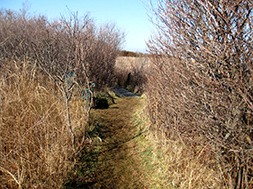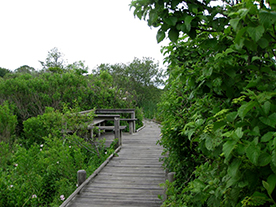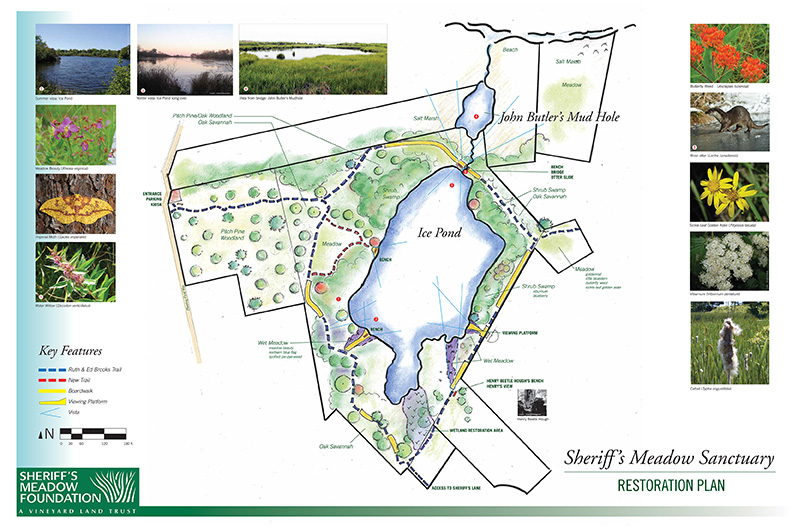Restoring the Sanctuary – Putting the Meadow Back in Sheriff’s Meadow
A section of the Sanctuary was inundated with porcelain berry. The Norway spruce and eastern white pine had grown thick and dense, and since little pruning had been done over the years, most of their lower branches and nearly all of the red cedars had died. In his speech at the Sheriff’s Meadow’s annual dinner in 2011, Executive Director Adam Moore described it this way: “Views that once rewarded the walker have become obscured, invasive plants are throttling native ones, boardwalks need replacement and the trails have become too narrow.”
No longer.
After eight years, Sheriff’s Meadow Foundation (SMF) is nearing completion of its effort to restore its namesake property, Sheriff’s Meadow Sanctuary. As SMF Board President Brien O’Brien described it at the 2018 Summer Benefit, “We’re trying to put the meadow back in Sheriff’s Meadow.”
The project to restore the Sanctuary began in 2010.
Kristen Geagan, Director of Stewardship, listened carefully as then SMF Board President Emily Bramhall described in detail what the property once looked like. “Emily had a vision of how it was when she was a child, it was much more open,” recalled Ms. Geagan. “I took that vision and looked at it through an ecological lens.”
“We began by improving access along the Ruth and Ed Brooks Trail, and the access routes to the pond,” said Mr. Moore. “Steve Ewing and his team at Aquamarine Dock Builders replaced all of the old boardwalks, which were rotting and rickety, with sturdy new ones made of island-grown pitch pine.”
“I initially had some reservations,” admitted Mr. Ewing (a former SMF board member). “There’s always a conflict between how much you open land, how much maintenance to do, or whether to leave it natural.” He added that after walking the property with Ms. Geagan and SMF board member Chris Alley, “I was sold that something needed to be done, and could be done, without losing the spirit of the land. We pruned as minimally as we could and we saw that these were really important ways to get people to see the beauty of this place.”
SMF Property Manager Bill Bridwell recalled, “When we first went in, it was like a jungle, thick with invasive bittersweet, autumn olives, and honeysuckle.” He added, “But now you can see how beautiful it is.”
Work continued in the upland meadows at the Sanctuary, where encroaching vegetation was cut and removed, restoring long-lost fields and vistas, and where native little bluestem grasses have been successfully nurtured from sown seeds and planted plugs.
A considerable amount of work concerned invasive plants, especially porcelain berry and Japanese holly. Near the Sheriff’s Lane entrance to the Sanctuary, porcelain berry vines had utterly smothered all of the other vegetation, and were it not for Mr. Bridwell’s persistent trimming, this invasive vine would have completely blocked the trail. Beside the pond, Japanese hollies and an invasive, exotic form of willow had spread in many directions, and removing these plants required a significant amount of effort.

2008 boardwalk, John Butler’s mudhole
Much of the restoration work involved the planting of native trees and shrubs, such aseastern red cedars, bayberries, viburnum, highbush blueberries, and red maples. These plants help to strategically screen from view neighboring houses and fences, in an effort to provide as natural a setting as possible for a sanctuary that is actually ringed by houses and very close to town.

2018 boardwalk, John Butler’s mudhole
In removing invasive plants beside the pond, remnants of the old ice house were uncovered. This historic area, near the Sheriff’s Lane entrance, offers a possibility for future historic interpretation.
One of the most successful aspects of the Sanctuary restoration has been the establishment of “wet meadow” areas on the edges of the ponds. These wet meadows are distinct from dry, upland meadows, and they are in short supply on the island, as the grasses, sedges and herbaceous plans of wet meadows quickly give way to tougher, taller, woody shrubs, unless carefully tended. These meadows now feature a variety of beautiful flowering plants, including the cardinal flower, blue vervain, and purple agalinis.
“There’s still ongoing invasive species work, which can depress you if you let it. I try not to let it depress me.” Ms. Geagan explained, “The invasives can take over so you don’t get the diversity, you’ll just have that one species which isn’t good for birds, or insects.”
Foundation staff members, board members, volunteers, and contractors have worked to restore upland meadows, wet meadows, and natural habitats, remove invasive plants, re-opening occluded views, improve the Ruth and Ed Brooks Trail, and enhance access to the pond and the meadow throughout the Sanctuary restoration process.
The restoration work has been made possible entirely by the generosity of donors who love the Sanctuary, many of whom live in the neighborhood. Donors have given or pledged over $650,000 to restore the Sanctuary and endow its perpetual care. The most recent donation comes from Donaroma’s Nursery and Landscape Services, which is conducting all of its current work at a 50% discount.
None of the work at the Sanctuary would be possible without the support, financial and otherwise, from all of our neighbors and donors. The Foundation thanks its neighbors and donors for their patience, for access over their properties, for tolerating machinery and noise during winter work sessions, for their helpful advice and constructive criticism, and for their abiding love for this original sanctuary.


